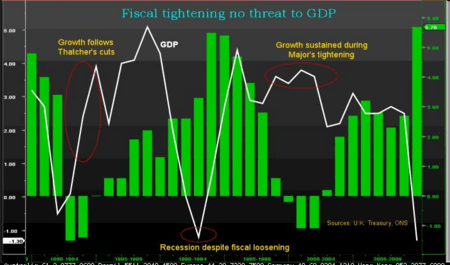
Would cutting spending “risk the recovery?” This claim is, literally, Gordon Brown’s re-election manifesto. He is hoping that the Tories haven’t learned to use numbers as weapons – so any economic message he has will not be effectively countered. In fact, his claim is very easily exposed as being bogus by a simple look at recent British economic history. Bloomberg’s Chart of the Day shows that economic growth in the past two recessions (white line) was not at all threatened by fiscal tightening (green graph). Even Goldman Sachs – which is acquiring a reputation as the Labour Party’s house broker – is conceding the central point. I hope Bloomberg won’t sue me for copyright if I reproduce their excellent analysis which accompanies their graph.
“The U.K. economy enjoyed growth during fiscal squeezes in the early 1980s and mid-1990s, calling into question Prime Minister Gordon Brown’s assertion that cutting the deficit too soon would wreck the recovery.
The CHART OF THE DAY compares annual change in gross domestic product in white with cyclically adjusted public sector net borrowing, a measure of the fiscal stance. Each is for the year ending March 31. Green bars below zero indicate a tightening of the Treasury’s purse strings. Rising bars show a loosening.
‘Simple models say that the more open the economy, the less impact fiscal policy has on aggregate demand,’ Ben Broadbent, an economist at Goldman Sachs Group Inc. in London, wrote in a note on Dec. 10. ‘In line with this, the two other periods of fiscal tightening in the past 30 years — the early 1980s and the mid-1990s — saw quite strong economic growth.’
Britain’s budget deficit will peak next year at 13.2 percent of GDP, the most in the Group of 20 nations, according to the International Monetary Fund. Chancellor of the Exchequer Alistair Darling on Dec. 9 outlined plans to cut the shortfall in half in four years, saying a quicker reduction risks ‘putting the recovery at risk.’
In March 1981, at the end of more than a year of recession, Margaret Thatcher’s Conservative government cut spending and raised personal and indirect taxation to bring the deficit and inflation under control. Growth resumed in the second quarter, setting the stage for almost a decade of expansion.
John Major’s Conservatives raised taxes and slashed spending from 1994 to repair the damage wrought by the early 1990s recession. The economy expanded 4.4 percent in fiscal 1995 and averaged almost 3 percent growth in each of the following two years.”







Comments